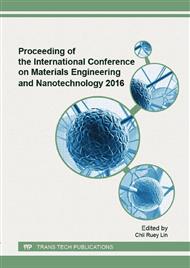[1]
G. Korotcenkov, Metal oxides for solid-state gas sensors: What determines our choice?, Materials Science and Engineering B 139 (2007) 1-23.
DOI: 10.1016/j.mseb.2007.01.044
Google Scholar
[2]
E. Comini, Metal oxide Nano-crystals for gas sensing, Anal. Chim. Acta. 568 (2006) 28 - 40.
DOI: 10.1016/j.aca.2005.10.069
Google Scholar
[3]
O. A. Ageev, A. P. Dostanko, E. G. Zamburg, et. al., Electrical and Optical Properties of Zinc Oxide Films Deposited by the Ion Beam Sputtering of an Oxide Target, Semiconductors 48 (9) (2014) 1274-1279.
DOI: 10.1134/s1063782614090073
Google Scholar
[4]
O. A. Ageev, D.A. Golosov, et. al., Researching Influence of IBAD PLD Parameters on Properties of Nanocrystalline ZnO Thin Films, App. Mech. and Mat. 481 (2014) 55-59.
DOI: 10.4028/www.scientific.net/amm.481.55
Google Scholar
[5]
O.A. Ageev, E.Y. Gusev, E.G. Zamburg, et. al., Nanocrystalline ZnO Films Grown by PLD for NO2 and NH3 Sensor App. Mech. and Materials 475- 476 (2014) 446-450.
DOI: 10.4028/www.scientific.net/amm.475-476.446
Google Scholar
[6]
O.A. Ageev, A.P. Dostanko, E.G. Zamburg, et. al., Effect of the Processes in the Laser Ablation Plume on the Resistivity and Morphology of Nanocrystalline ZnO Films, Phys. of the Sol. St. 57 (2015) 2093-(2098).
DOI: 10.1134/s1063783415100029
Google Scholar
[7]
G. Korotcenkov, Gas response control through structural and chemical modification of metal oxide films: state of the art and approaches, Sensors and Actuators B 107 (2005) 209-232.
DOI: 10.1016/j.snb.2004.10.006
Google Scholar
[8]
K. Ellmer, Resistivity of polycrystalline zinc oxide: Current status and physical limit, J. Phys. D: Appl. Phys. 34 (2001) 3097-3108.
DOI: 10.1088/0022-3727/34/21/301
Google Scholar
[9]
N. Barsan, U. Weimar, Conduction model of metal oxide gas sensors, J. of Electroceramics 7 (2001) 143-167.
Google Scholar
[10]
G. Sakai, et. al., Theory of gas-diffusion controlled sensitivity for thin film semiconductor gas sensor, Sensors and Actuators B 80 (2001) 125-131.
DOI: 10.1016/s0925-4005(01)00890-5
Google Scholar
[11]
K. Ellmer, A. Klein, B. Rech, Transparent Conductive Zinc Oxide: Basics and Applications in Thin Film Solar Cells, Springer-Verlag: Berlin, Germany, 2008, pp.35-72.
DOI: 10.1007/978-3-540-73612-7
Google Scholar
[12]
J.F. Chang, et. al., The effects of thickness and operation temperature on ZnO: Al thin film CO gas sensor, Sensors and Actuators B 84 (2002) 258-264.
DOI: 10.1016/s0925-4005(02)00034-5
Google Scholar


